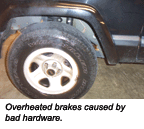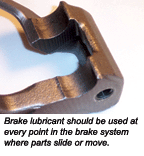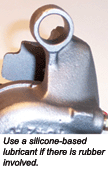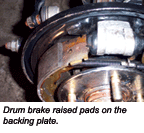 Ever hear the saying, “The squeaky wheel gets the grease?” The saying actually refers to persistence and never giving up — not greasing the brakes.
Ever hear the saying, “The squeaky wheel gets the grease?” The saying actually refers to persistence and never giving up — not greasing the brakes.
Staying power is what special-purpose brake lubricants are supposed to have when the going gets hot. The front brakes on many FWD cars, as well as large SUVs, can get extremely hot when braking hard or braking repeatedly. Mountain driving, aggressive driving in stop-and-go traffic or off-road, towing a trailer, hauling a heavier than normal load, etc., can all increase the operating temperature of the brake system.
Under extreme driving conditions, some lubricants can’t stand the heat and melt off, evaporate, oxidize or burn. That’s why ordinary, general-purpose chassis grease should never be used for lubricating brake components. It won’t hold up. What’s needed is a specially formulated, high-temperature brake grease that can withstand the heat, and also not harm rubber seals or plastic bushings. Petroleum-based lubricants should never be used for brake assembly work because mineral oils can cause seals to swell and fail.
What needs to be lubricated? Mechanical components in the brake system that slide, move, rotate or bear pressure. Why do lubricants work to reduce some brake noises? It is a simple answer. When a caliper finger is lubricated at the point it touches the brake pad, the lubricant creates a boundary layer that separates the vibration of the brake pad from exciting the caliper finger and the caliper. This is one approach to solving NVH problems that can have its limitations. Lubricants do not dampen forces by adding extra mass like a brake shim. Also, lubricants cannot fill in pitting on brake slides. Additionally, lubricants do not insulate against vibration and is effective for some frequencies.

The primary lubrication points in a drum brake include the raised pads on the backing plate that support the shoes, the star adjuster mechanism, hinge points for self-adjusters or the parking brake linkage, and the parking brake cables.
In disc brakes, lubrication points include the caliper slides and bushings, self-adjuster mechanisms on rear disc brakes with locking calipers, and the parking brake cables and linkage. Brake grease can also be used to dampen vibrations between disc brake pads and caliper pistons. But, it should not be applied between the pad and any noise suppression shims that may be used. Use it on the back of a bare pad or between the pad shim and caliper.
One place you never, ever want to get any grease on is the friction surface of a brake lining — which is another reason for not using low-temperature or petroleum-based lubricants which can melt, run off and foul the linings. Grease-contaminated shoes or pads will be grabby and usually cause a brake pull to one side. The only cure is to replace the fouled linings with new ones. Cleaning is out of the question because solvents and cleaners can adversely affect the linings, too.
When it comes to brake lubricants, grease is a dirty word. Brake lubricants are specially-formulated products that are not the same as ordinary chassis grease or even multi-purpose grease.

The kind of grease that’s used to lube tie rod ends, ball joints and U-joints is not the same as the lubricants that are required for brake system components. In fact, ordinary grease may cause serious problems if it is used on brake hardware or hydraulic components.
As every technician should know, many petroleum-based products are not compatible with the seal materials that are commonly used inside brake systems. Petroleum-based grease or oil should never come into contact with the rubber seals, pistons or other internal parts in a master cylinder, brake caliper or wheel cylinder. If it does, the entire brake system should be considered contaminated. This will require draining and flushing the entire system, and replacing all the major hydraulic components! Why? Because petroleum-based products can cause incompatible seal materials to swell, rupture and leak – which could lead to fluid loss and brake failure.
Brake lubricants, by comparison, are specially formulated products that are designed exclusively for brake applications and nothing else. The chemicals in these products are compatible with all commonly used seal materials, and will not harm these parts.
Several Basic Types
There are several basic types of brake lubricants: those that are designed for lubricating hardware and mechanical components and typically contain a high percentage of solids (dry film lubricants), and those that are designed for lubricating seals, boots and other internal parts when assembling calipers, wheel cylinders and master cylinders.
Brake lubricant for hardware is a special high temperature grease designed to provide long-lasting protection. The lubricant may be a synthetic or silicone-based product. Synthetic-based, boundary-type lubricants that come in a tube, paste or stick form have a high solids content and typically contain a variety of friction-reducing ingredients such as molybdenum disulfide (moly or MOS2) and graphite.
Moly and graphite are both dry-film lubricants that can handle high temperatures and pressures. Some of these products are rated to withstand intermittent temperatures as high as 2,400 degrees F!
Moly and graphite have excellent staying power and won’t evaporate or burn off over time, and they won’t attract or hold dirt like ordinary “wet” greases can. This type of product is ideal for high temperature applications where long-lasting metal-to-metal lubrication is essential for good brake performance.
Silicone-based brake grease is designed for caliper and wheel cylinder assembly work because silicone is an excellent lubricant for rubber and plastic. It is compatible with all rubber compounds including nitrile, teflon, nylon and other synthetic rubbers. Silcone’s normal working range is -40 degrees F to 400 degrees F. But it does not have the high temperature staying power of a high solids synthetic lubricant, and it is a “wet” lubricant that can attract and hold dirt, making it less suited for lubricating external metal-to-metal contact points, such as caliper mounts and shoe pads. This type of product is best suited for assembling calipers, wheel cylinders and master cylinders.
Another synthetic-based brake lubricant uses polyalphaolefin (PAO) as its main ingredient. PAO-based brake lubricants are also excellent for assembly work and lubricating seals and boots. PAO offers superior rust protection, making it well-suited for brake systems operated in wet environments.
PAO brake lubricant may also include various amounts of moly, graphite and teflon to enhance its lubricating properties. This type of product can withstand intermittent temperatures of up to 600 degrees F, and can be used for both assembly and external lubrication.
White lithium is a low-temperature grease that can be used to lubricate drum brake hardware and backing plates, but lacks the heat-resistance for front disc brake applications. So this type of grease is not the best choice for general brake work. Regardless of what type of brake lubricant you choose, always follow the supplier’s recommendations as to how their product should be used.
Where to Use It
Brake lubricant should be used at every point in the brake system where parts slide or move. With disc brakes, lubrication points include the caliper slides, pins and bushings, the contact points where the pads slide within the caliper housing, self-adjuster mechanisms on rear disc brakes with locking calipers, and the parking brake cables and linkage.
Brake lubricant can also be used to dampen vibrations between disc brake pads and caliper pistons. But it should not be applied between the pads and any noise suppression shims that may be used. Use it on the back of a bare pad or between the pad shim and caliper – and use it sparingly. Don’t glob it on.
The primary lubrication points in rear drum brakes include the raised pads on the backing plates that support the shoes, the star adjuster mechanisms, hinge points for self-adjusters or the parking brake linkage, and the parking brake cables.
One place you never, ever want to get any grease on is the friction surface of a brake lining – which is another reason for not using low-temperature or petroleum-based lubricants which can melt, run off and foul the linings. Grease contaminated shoes or pads will be grabby and usually cause a brake pull to one side. The only cure is to replace the fouled linings with new ones. Cleaning is out of the question because solvents and cleaners can adversely affect the linings, too.
For lubricating hydraulic components, such as the piston seals inside calipers and wheel cylinders, you can use a silicone-based brake lubricant or ordinary brake fluid. This type of lubricant will help assure smooth movement of the seals in their bores, and will help prevent these parts from sticking or corroding.
There are three criteria to remember when selecting a brake lubricant. First, does it say that its a brake lubricant on the package? If not, do not use. Some lubricates may say they are a silicone or molybdenum disulfide based, but they may not be formulated to work at on brakes. Second, look at the effective temperature range or the lubricant. At minimum, a lubricant should be able to handle 400 degrees Fahrenheit. Third, check to see if it contains petroleum distillates or any substance that can be detrimental to soft parts.













